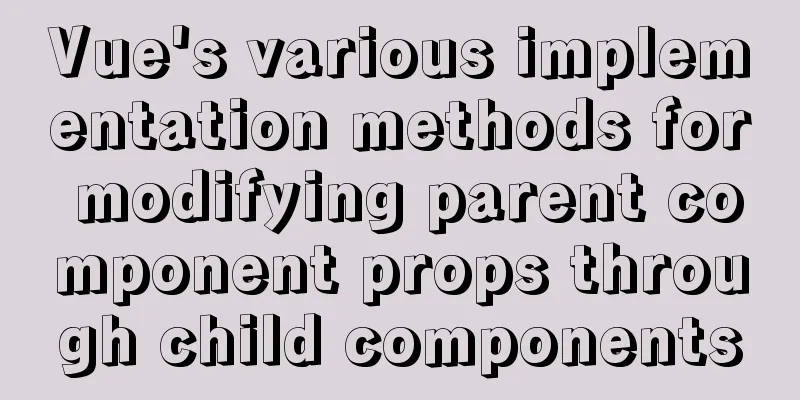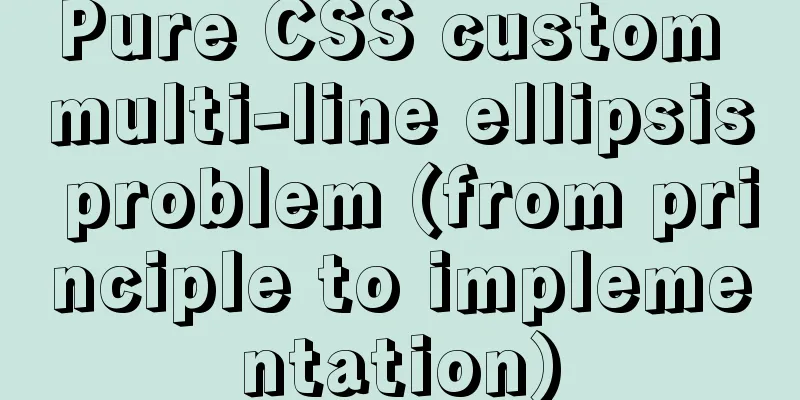Vue's various implementation methods for modifying parent component props through child components

PrefaceIn actual work project development, there are often scenarios where the parent component passes values to the child component first, and then the child component renders and displays the scene. Below I summarize some of the methods I have encountered and used in my current work, which can be regarded as a reference for implementation methods and ideas. If you have any misunderstandings or other methods, please leave a message in the comment area for guidance~ Common methodsIt is recommended to follow the one-way prop transmission rule, both basic data types and reference data types are acceptable. 1. Modify prop by listening to the child component emit event through the parent component onprinciple:
The parent component code is as follows:
<template>
<div style="background-color: skyblue;">
<h3>Modify prop by listening to child component emit events through parent component on</h3>
<div>parent obj:{{ obj }}</div>
<div>parent msg:{{ msg }}</div>
<!-- When the parent component calls the child component, it listens to the emit event triggered by the child component through on to receive the value and update the user-->
<emitChild
:obj="obj"
:msg="msg"
@update-obj="updateObj"
@update-msg="updateMsg"
/>
</div>
</template>
<script>
import emitChild from './components/emitChild'
export default {
name: 'emitUpdate',
components:
emitChild
},
data () {
return {
obj: {
name: 'zhangsan',
age: 18
},
msg: 'hello'
}
},
methods: {
// Listen for events triggered by child components and update obj in data
updateObj (key, newVal) {
this.obj[key] = newVal
},
// Listen for events triggered by child components and update msg in data
updateMsg (newVal) {
this.msg = newVal
}
}
}
</script>The subcomponent code is as follows:
<template>
<div style="background-color: pink;">
<div>
<span>Modify name:</span>
<!-- Here, the binding value is value, because the input is mainly used to display prop data, and the actual modification is not in the subcomponent. The subcomponent is only used as a modification trigger source-->
<!-- Bind input event as the entry point of the trigger source -->
<input type="text" :value="obj.name" @input="updateObj($event, 'name')">
</div>
<div>
<span>Modify age:</span>
<input type="text" :value="obj.age" @input="updateObj($event, 'age')">
</div>
<div>
<span>Modify msg:</span>
<input type="text" :value="msg" @input="updateMsg($event.target.value)">
</div>
</div>
</template>
<script>
export default {
name: 'emitUpdateChild',
props: {
obj: {
type: Object,
default: () => {}
},
msg: {
type: String,
default: ''
}
},
methods: {
// Notify the parent component to update obj
updateObj ($event, key) {
// Receive the input value and the corresponding attribute in obj that needs to be updated, and then pass it back to the parent component // The parent component can know which attribute value in obj the child component needs to update this.$emit('update-obj', key, $event.target.value)
},
// Notify the parent component to update msg
updateMsg (newVal) {
this.$emit('update-msg', newVal)
}
}
}
</script>2. Modify prop through parent component sync modifier + child component emit eventprinciple:
The parent component code is as follows:
<template>
<div style="background-color: skyblue;">
<h3>Modify prop through parent component sync modifier + child component emit event</h3>
<div>parent obj:{{ obj }}</div>
<div>parent msg:{{ msg }}</div>
<!-- When the parent component calls the child component to pass props, just add .sync after the prop -->
<syncChild :obj.sync="obj" :msg.sync="msg" />
<!--
sync is actually equivalent to executing @listener triggered event name = "property name in parent data = value passed by emit (ie $event)"
This piece of code -->
<!-- The effect is equivalent to the following code, so there is no need to define methods to modify data in the parent component methods-->
<!--
<syncChild
:obj="obj"
:msg="msg"
@update-obj="obj = $event"
@update-msg="msg = $event"
/>
-->
</div>
</template>
<script>
import syncChild from './components/syncChild'
export default {
name: 'syncUpdate',
components:
syncChild
},
data () {
return {
obj: {
name: 'zhangsan',
age: 18
},
msg: 'hello'
}
}
}
</script>The subcomponent code is as follows:
<template>
<div style="background-color: pink;">
<div>
<span>Modify name:</span>
<!-- Here, the binding value is value, because the input is mainly used to display prop data, and the actual modification is not in the subcomponent. The subcomponent is only used as a modification trigger source-->
<!-- Bind input event as the entry point of the trigger source -->
<input type="text" :value="childObj.name" @input="updateObj($event, 'name')">
</div>
<div>
<span>Modify age:</span>
<input type="text" :value="childObj.age" @input="updateObj($event, 'age')">
</div>
<div>
<span>Modify msg:</span>
<input type="text" :value="msg" @input="updateMsg($event.target.value)">
</div>
</div>
</template>
<script>
// Here we introduce the cloneDeep deep copy method of the lodash tool library // Official document address https://www.lodashjs.com/
import { cloneDeep } from 'lodash'
export default {
name: 'emitUpdateChild',
props: {
obj: {
type: Object,
default: () => {}
},
msg: {
type: String,
default: ''
}
},
data () {
return {
// Here, prop's obj is copied through deep copy, mainly for:
// 1. Distinguish two objects (reference types) using different memory addresses // 2. Keep all values in the object to facilitate child component rendering/modification/returning childObj: cloneDeep(this.obj)
}
},
methods: {
// Notify the parent component to update obj
updateObj ($event, key) {
// Receive the input value and the corresponding attribute in childObj that needs to be updated // Then update childOBj and pass it back to the parent component // The parent component can directly update the obtained childObj to the obj of data this.childObj[key] = $event.target.value
this.$emit('update:obj', this.childObj)
},
// Notify the parent component to update msg
updateMsg (newVal) {
this.$emit('update:msg', newVal)
}
}
}
</script>TipsIt mainly targets reference data types, bypassing Vue's prop detection mechanism. It depends on whether the project specifications allow this writing. 3. Modify prop through dataPrerequisite: Only reference data types can be implemented principle:
The parent component code is as follows:
<template>
<div style="background-color: skyblue;">
<h3>Modify prop by assigning it to data</h3>
<div>parent obj:{{ obj }}</div>
<div>parent msg:{{ msg }}</div>
<dataChild :obj="obj" :msg.sync="msg" />
</div>
</template>
<script>
import dataChild from './components/dataChild'
export default {
name: 'dataUpdate',
components:
dataChild
},
data () {
return {
obj: {
name: 'zhangsan',
age: 18
},
msg: 'hello'
}
}
}
</script>The subcomponent code is as follows:
<template>
<div style="background-color: pink;">
<div>
<span>Modify name:</span>
<!-- Here, because we assign prop directly to data, we can directly use v-model two-way binding to modify the data-->
<input type="text" v-model="dataObj.name">
</div>
<div>
<span>Modify age:</span>
<input type="text" v-model="dataObj.age">
</div>
<div>
<span>Modify msg:</span>
<!-- Here is another way to modify basic data types, which can be implemented through watch listeners-->
<input type="text" v-model="dataMsg">
</div>
</div>
</template>
<script>
export default {
name: 'dataChild',
props: {
obj: {
type: Object,
default: () => {}
},
msg: {
type: String,
default: ''
}
},
data () {
return {
// When the reference data type is directly assigned, it is a shallow copy, only the memory address is copied, and modifying one will affect the other dataObj: this.obj,
// When basic data types are directly assigned, the values are copied, and modifying one will not affect the other dataMsg: this.msg
}
},
watch:
// Here we listen to the dataMsg copied from data, and when it is modified, execute emit to notify the parent component to update dataMsg (newVal) {
this.$emit('update:msg', newVal)
}
}
}
</script>4. Modify prop through computed propertyPrerequisite: Only reference data types can be implemented principle:
The parent component code is as follows:
<template>
<div style="background-color: skyblue;">
<h3>Modify props through computed property monitoring</h3>
<div>parent obj:{{ obj }}</div>
<div>parent msg:{{ msg }}</div>
<computedChild :obj="obj" :msg.sync="msg" />
</div>
</template>
<script>
import computedChild from './components/computedChild'
export default {
name: 'computedUpdate',
components:
computedChild
},
data () {
return {
obj: {
name: 'zhangsan',
age: 18
},
msg: 'hello'
}
}
}
</script>The subcomponent code is as follows:
<template>
<div style="background-color: pink;">
<div>
<span>Modify name:</span>
<!-- Here, because we listen to prop directly through the computed property, we can directly use v-model two-way binding to modify the data-->
<input type="text" v-model="computedObj.name">
</div>
<div>
<span>Modify age:</span>
<input type="text" v-model="computedObj.age">
</div>
<div>
<span>Modify msg:</span>
<!-- Here is another way to modify basic data types, which can be achieved through the setter of the computed property-->
<input type="text" v-model="computedMsg">
</div>
</div>
</template>
<script>
export default {
name: 'computedChild',
props: {
obj: {
type: Object,
default: () => {}
},
msg: {
type: String,
default: ''
}
},
computed: {
computedObj() {
// Here, the reference data type obj is directly returned. At this time, computedObj is equivalent to obj
// So it is a shallow copy, only the memory address will be copied, and modifying one will affect the other return this.obj
},
computedMsg: {
get () {
// Every time the prop is updated, the getter method of the calculated property will be triggered to obtain the latest value // When returning the basic data type directly, the value is copied, and modifying one will not affect the other return this.msg
},
set (newVal) {
// Here we use the setter method of the calculated property to trigger the emit when the value is modified to notify the parent component to update the value this.$emit('update:msg', newVal)
}
}
}
}
</script>This concludes this article about several ways to implement Vue to modify the prop of a parent component through a child component. For more relevant content about Vue child components modifying the prop of a parent component, please search for previous articles on 123WORDPRESS.COM or continue to browse the following related articles. I hope you will support 123WORDPRESS.COM in the future! You may also be interested in:
|
<<: Pessimistic locking and optimistic locking in MySQL
>>: Solution to running out of MySQL's auto-increment ID (primary key)
Recommend
MySQL uses covering index to avoid table return and optimize query
Preface Before talking about covering index, we m...
Comparison of 5 CSS scrolling ceiling implementation methods (performance upgrade version)
Preview of revised version This article was writt...
Pure CSS to achieve the list pull-down effect in the page
You may often see the following effect: That’s ri...
The difference between the four file extensions .html, .htm, .shtml and .shtm
Many friends who have just started to make web pag...
Example code for implementing a simple search engine with MySQL
Table of contents Preface Introduction ngram full...
Introduction to document.activeELement focus element in JavaScript
Table of contents 1. The default focus is on the ...
HTML user registration page settings source code
Design the web page shown above: <!DOCTYPE htm...
MySQL and MySQL Workbench Installation Tutorial under Ubuntu
Ubuntu install jdk: [link] Install Eclipse on Ubu...
HTML design pattern daily study notes
HTML Design Pattern Study Notes This week I mainl...
A complete guide to the Docker command line (18 things you have to know)
Preface A Docker image consists of a Dockerfile a...
XHTML Getting Started Tutorial: Form Tags
<br />Forms are an important channel for use...
React implements a highly adaptive virtual list
Table of contents Before transformation: After tr...
How to install binary MySQL on Linux and crack MySQL password
1. Make sure the system has the required libaio s...
Detailed explanation of the reasons why MySQL connections are hung
Table of contents 1. Background Architecture Prob...
Windows Server 2016 Quick Start Guide to Deploy Remote Desktop Services
Now 2016 server supports multi-site https service...













